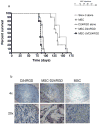Reduction of nontarget infection and systemic toxicity by targeted delivery of conditionally replicating viruses transported in mesenchymal stem cells
- PMID: 19876078
- PMCID: PMC4159049
- DOI: 10.1038/cgt.2009.67
Reduction of nontarget infection and systemic toxicity by targeted delivery of conditionally replicating viruses transported in mesenchymal stem cells
Abstract
The fiber-modified adenoviral vector Delta-24-RGD (D24RGD) offers vast therapeutic potential. Direct injection of D24RGD has been used to successfully target ovarian tumors in mice. However, systemic toxicity, especially in the liver, profoundly limits the efficacy of direct viral vector delivery. Mesenchymal stem cells (MSC) have the ability to function as a vector for targeted gene therapy because of their preferential engraftment into solid tumors and participation in tumor stroma formation. We show that MSC-guided delivery of D24RGD is specific and efficient and reduces the overall systemic toxicity in mice to negligible levels compared with D24RGD alone. In our model, we found efficient targeted delivery of MSC-D24RGD to both breast and ovarian cell lines. Furthermore, immunohistochemical staining for adenoviral hexon protein confirmed negligible levels of systemic toxicity in mice that were administered MSC-D24RGD compared with those that were administered D24RGD. These data suggest that delivery of D24RGD through MSC not only increases the targeted delivery efficiency, but also reduces the systemic exposure of the virus, thereby reducing overall systemic toxicity to the host and ultimately enhancing its value as an anti-tumor therapeutic candidate.
Figures







Similar articles
-
Mesenchymal Stem Cell-Mediated Delivery of an Oncolytic Adenovirus Enhances Antitumor Efficacy in Hepatocellular Carcinoma.Cancer Res. 2019 Sep 1;79(17):4503-4514. doi: 10.1158/0008-5472.CAN-18-3900. Epub 2019 Jul 9. Cancer Res. 2019. PMID: 31289131
-
Treatment of chemotherapy resistant ovarian cancer with a MDR1 targeted oncolytic adenovirus.Gynecol Oncol. 2011 Oct;123(1):138-46. doi: 10.1016/j.ygyno.2011.06.007. Epub 2011 Jul 13. Gynecol Oncol. 2011. PMID: 21741695
-
Mesenchymal progenitor cells as cellular vehicles for delivery of oncolytic adenoviruses.Mol Cancer Ther. 2006 Mar;5(3):755-66. doi: 10.1158/1535-7163.MCT-05-0334. Mol Cancer Ther. 2006. PMID: 16546991
-
Mesenchymal stem cell-mediated delivery of therapeutic adenoviral vectors to prostate cancer.Stem Cell Res Ther. 2019 Jun 25;10(1):190. doi: 10.1186/s13287-019-1268-z. Stem Cell Res Ther. 2019. PMID: 31238944 Free PMC article.
-
Mesenchymal stem cells: potential precursors for tumor stroma and targeted-delivery vehicles for anticancer agents.J Natl Cancer Inst. 2004 Nov 3;96(21):1593-603. doi: 10.1093/jnci/djh299. J Natl Cancer Inst. 2004. PMID: 15523088
Cited by
-
The limiting factors of oncolytic virus immunotherapy and the approaches to overcome them.Appl Microbiol Biotechnol. 2020 Oct;104(19):8231-8242. doi: 10.1007/s00253-020-10802-w. Epub 2020 Aug 20. Appl Microbiol Biotechnol. 2020. PMID: 32816087 Review.
-
Effects of Cell Density and Microenvironment on Stem Cell Mitochondria Transfer among Human Adipose-Derived Stem Cells and HEK293 Tumorigenic Cells.Int J Mol Sci. 2022 Feb 11;23(4):2003. doi: 10.3390/ijms23042003. Int J Mol Sci. 2022. PMID: 35216117 Free PMC article.
-
Oncolytic virotherapy for ovarian cancer.Oncolytic Virother. 2012 Aug;1:1-21. doi: 10.2147/ov.s31626. Oncolytic Virother. 2012. PMID: 25977900 Free PMC article.
-
Concise Review: Mesenchymal Stem Cell-Based Drug Delivery: The Good, the Bad, the Ugly, and the Promise.Stem Cells Transl Med. 2018 Sep;7(9):651-663. doi: 10.1002/sctm.18-0024. Epub 2018 Aug 1. Stem Cells Transl Med. 2018. PMID: 30070053 Free PMC article. Review.
-
Engineered retargeting to overcome systemic delivery challenges in oncolytic adenoviral therapy.Mol Ther Oncol. 2025 Jun 6;33(2):201005. doi: 10.1016/j.omton.2025.201005. eCollection 2025 Jun 18. Mol Ther Oncol. 2025. PMID: 40546315 Free PMC article. No abstract available.
References
-
- Heise C, Hermiston T, Johnson L, Brooks G, Sampson-Johannes A, Williams A, et al. An adenovirus E1A mutant that demonstrates potent and selective systemic anti-tumoral efficacy. Nat Med. 2000;6:1134–1139. - PubMed
-
- Kelly FJ, Miller CR, Buchsbaum DJ, Gomez-Navarro J, Barnes MN, Alvarez RD, et al. Selectivity of tag-72-targeted adenovirus gene transfer to primary ovarian carcinoma cells versus autologous mesothelial cells in vitro. Clin Cancer Res. 2000;6:4323–4333. - PubMed
-
- Tsuda H, Wada T, Ito Y, Uchida H, Dehari H, Nakamura K, et al. Efficient BMP2 gene transfer and bone formation of mesenchymal stem cells by a fiber-mutant adenoviral vector. Mol Ther. 2003;7:354–365. - PubMed
-
- Hemminki A, Belousova N, Zinn KR, Liu B, Wang M, Chaudhuri TR, et al. An adenovirus with enhanced infectivity mediates molecular chemotherapy of ovarian cancer cells and allows imaging of gene expression. Mol Ther. 2001;4:223–231. - PubMed
-
- Bauerschmitz GJ, Kanerva A, Wang M, Herrmann I, Shaw DR, Strong TV, et al. Evaluation of a selectively oncolytic adenovirus for local and systemic treatment of cervical cancer. Int J Cancer. 2004;111:303–309. - PubMed
MeSH terms
Grants and funding
LinkOut - more resources
Full Text Sources
Other Literature Sources

